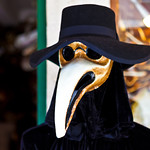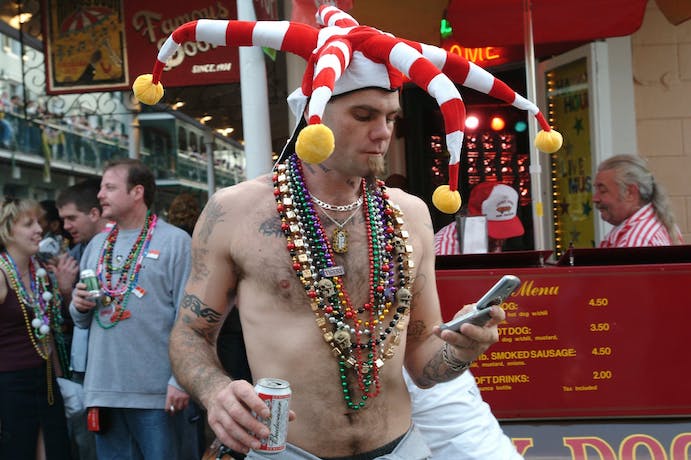Historically amongst the revelers at Venice’s celebrated Mardi Gras Carnival, are those costumed in the distinctive beaked mask of the Medico della Peste—the plague doctor. Wearing black robes and white gloves, those celebrants who deck the uniform of the Renaissance plague doctors are most recognizable by the long avian proboscis of the mask, with its inert eyes and its curved permanent frown. The eerie mask is historically accurate, long before it became just another bit of flash for Venice’s Mardi Gras celebration, it was used by physicians in the seventeenth-century who, believing that the plague was spread by fetid miasma in the air, would stuff the bird-like beak of the mask with dried herbs and flowers in a desperate attempt to stave off the swollen black buboes of the disease.

Medico della peste (Plague Doctor) – Venice, Italy. Image: Thomas Leplus/Flickr
Appropriated by carnival party-goers, the plague doctor mask is a reminder of Mardi Gras’ anxieties—the dusk before Ash Wednesday, the party preceding the 40 days of Lent, life within the looming specter of death. For Venetians living next to the noxious brown canals, wandering the crowded piazzas, shoved into the city’s ghettoes, plague wasn’t abstraction or metaphor.
John Kelly explains the contexts of Venice’s experience with pandemic in The Great Mortality: An Intimate History of the Most Devastating Plague of all Time, as “corpse-laden convoys shuttled back and forth through the choppy gray seas to the windswept islands… each cadaver got a grave dug exactly five feet deep, a last view of Venice, and a final prayer from a priest.” There will be no plague doctor masks in Venice this year, however. Carnival has been cancelled over fears surrounding the growing spread of the coronavirus.
The more things change, and all the rest. No need to make an argument for the utility of the humanities when such themes repeat like an idee fixe throughout history. What Mardi Gras represents is always worth considering, at this moment as much as any other. Not necessarily the strict theological implications of Mardi Gras’ relationship to Lent, but the more elemental, emotional, universal contact between the life of Fat Tuesday and the austerity of Ash Wednesday. Beyond the liturgical calendar there’s something intrinsic about those eternally nestled days, the ways in which we can measure the extremities of human experience between the lushness, the decadence, the celebration of Tuesday and the death of Wednesday. “Eat drink and be merry,” somebody once wrote.
From the medieval celebrations of Mardi Gras came one of the most useful critical terms in our cultural vocabulary—the carnivalesque. That term is most associated with the twentieth-century Russian literary critic Mikhail Bakhtin who, in his 1940 Rabelais and His World, argued that the carnivalesque was a radical mode, a means of briefly creating a world of subverted expectations and social inversions. During the celebrations, he wrote, “[all] were considered equal during carnival. Here, in the town square, a special form of free and familiar contact reigned among people who were usually divided by the barriers of caste, property, profession, and age.”
During carnival license was given to abolish the regular world; frequently the crowds would crown an “Abbot of Unreason” or a “Lord of Misrule,” a mocking pantomime of ecclesiastical and royal authority who was allowed to endure during that Tuesday as a rejection of the things of this world. Social expectations were turned upside down, economic expectations, political ones, religious ones. Carnival exemplifies the “joyful relativity of all structure and order,” and, as Bakhtin writes, “it crowns and uncrowns, inverts rank, exchanges roles, makes sense from nonsense and nonsense of sense.”
In this world of rigid social structures, carnival was a free-floating utopia, not of location but of duration, found not in a particular place but during a particular time. Carnival signified a subversive promise, a taste of the abolishment of those things which control our lives. Even death, the plague in the midst of the celebration, was to be mocked by the partygoers.
Academic debate has long centered around how radical the carnivalesque actually was. Revolutionary subversion of the status quo, or mere pressure gauge that allowed the working class to blow off some steam? Perhaps both? Regardless of its import during the Middle Ages and the Renaissance, Bakhtin emphasized that its aura had long since dissipated under the influence of industrial capitalism, when all dissent is immediately commodifiable.
If Mardi Gras did signal a sort of sanctioned denigration of the law at one time, an impartation of pure grace and spirit to those whose lives were so carefully regulated, then today it’s just one more excuse to sell things or drink to excess. Allon White and Peter Stalybrass note in The Politics and Poetics of Transgression, that for good and bad, “the forms, symbols, rituals and structures of carnival are among the fundamental aesthetics of modernism.” In other words, nothing is shocking if everything is; carnival never actually happens if it’s always going on.
Which is why, in our own season of inverted hierarchies, our universe of laughing meme-warriors and shit-posters, of Dadaist sneer and nihilistic rejection of any truth, it might be worth reestablishing the solemnity of Ash Wednesday for the benefit of the subversiveness of Fat Tuesday—for each needs the other. We’ve crowned plenty of Lords of Misrule over the past few years and, well, they certainly have proven how much they can misrule. It cheapens carnival, which is something deep, elemental, and intrinsic.
There’s a necessity to the complementary relationship between Mardi Gras and Lent, a way in which both make their own promises and demands of each other, and sustain themselves in that way. Carnival in its original form had the redemptive about it; but in order to turn the world upside down we have to know which direction is up in the first place.


